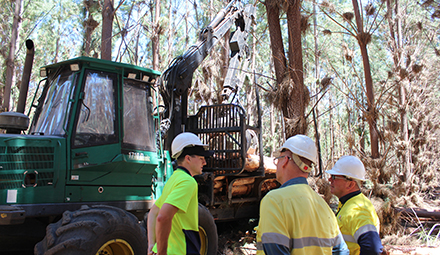
Spurred on by the devastating wildfires of the past few years including the Carr Fire and Camp Fire, state officials in California are pursuing ambitious plans to double the amount of wildland tree and brush thinning over the next five years. But they also acknowledge it is likely to be difficult to ramp up the process of clearing out the state’s overgrown and dangerous forests. Source: Redding
The state Legislature set aside US$1 billion to be spent over the next five years to double the amount of vegetation thinning on forests and wildlands throughout the state. That means the state will also need to increase the amount of forest acres treated annually from 250,000 to 500,000.
However, state officials acknowledge it could be difficult to meet that goal. And even if the state hits the mark, it may not be enough to prevent more catastrophic wildfires, said Helge Eng, deputy director of resource management for the California Department of Forestry and Fire Protection.
“Two hundred million (a year) is a lot of money, but unfortunately it’s not enough to solve the problem,” Eng said during a recent California Society of American Foresters meeting.
Other state officials noted that thinning the forests will require removing hundreds of tons of trees and brush from the forest. There also may not be enough lumber mills to cut commercial size trees and too few biomass plants to burn the other brush and slash removed from the forest during thinning.
That slash material is typically burned at biomass plants to generate electricity, officials said.
In 1971 there were 145 wood products facilities in California, according to the Forest Foundation. But by October 2017 there were only about 33 of those facilities left to mill timber or burn biomass, according to a foundation report.
It could also be a challenge to find enough skilled workers to work in the woods on prescribed burns and mechanical tree and brush removal, officials said.
“That’s a concern,” said Kevin Conway, state forests program manager for Cal Fire. “There are only so many loggers, so many RPFs (registered professional foresters) and equipment to go around in California,” Eng said.
The problem in the state’s forests and wildland areas has been well documented. Over the past 100 years federal and state officials have aggressively fought wildland fires, which were once a natural part of the landscape. As fires were restricted, forests became thicker and overgrown.
Beginning in the late 1980s the amount of timber harvested in the state began to decline, further increasing vegetation build up in the forest. Timber harvesting dropped from a high in 1988 of 4.6 million board feet that year to about 1.8 million board feet in 2001, according to Cal Fire.
The annual timber harvest on public and private lands in the state has remained fairly constant since then, according to agency statistics. Aggressive fire suppression, drought, lack of thinning and bark beetles that have killed an estimated 147 million trees statewide have left forests more prone to “mega fires,” Eng said.
Ten of the state’s 20 largest fires occurred within the past 10 years, Eng pointed out. And those fires have become more deadly, he said, noting the 85 people killed in the Camp Fire in Butte County last year and the 22 people killed in the Tubbs Fire in Napa and Sonoma counties in 2017.
“Eighty-five people is really mind boggling,” Eng said. “We really can’t afford another Camp Fire like we had in Paradise. “I think the new governor realizes this is not sustainable and we have to do something,” he said.
But the forest thinning requires removing thousands of trees and burning brush during the fall and winter, he said. Those two things may not be acceptable to some of the public, he said.
“It’s still an open question about what the public will accept for forest thinning,” he said, showing a PowerPoint slide with a photo of a forest where the adult trees were thinned out to about 20-feet apart and brush around them had been removed.
“I think there is a significant public education campaign ahead of us as foresters to get the public to understand that,” he said.
He also wondered whether there has been adequate research into whether aggressive forest thinning is the proper remedy for the forests’ ailment.
“We really don’t have the science to back up this fairly aggressive, fuels reduction program,” he said. But Steve Eubanks, a forestry consultant, said to adequately address the California’s forest issues the state should double the amount it plans to spend on forest thinning to $10 billion.
He and Tad Mason, also a member of the foresters’ association, want state, federal and private forestry officials to meet again in a year to make sure the state is meeting its forest thinning goals.
“The pace and scale of wildfire is getting way ahead of management,” Eubanks said.







